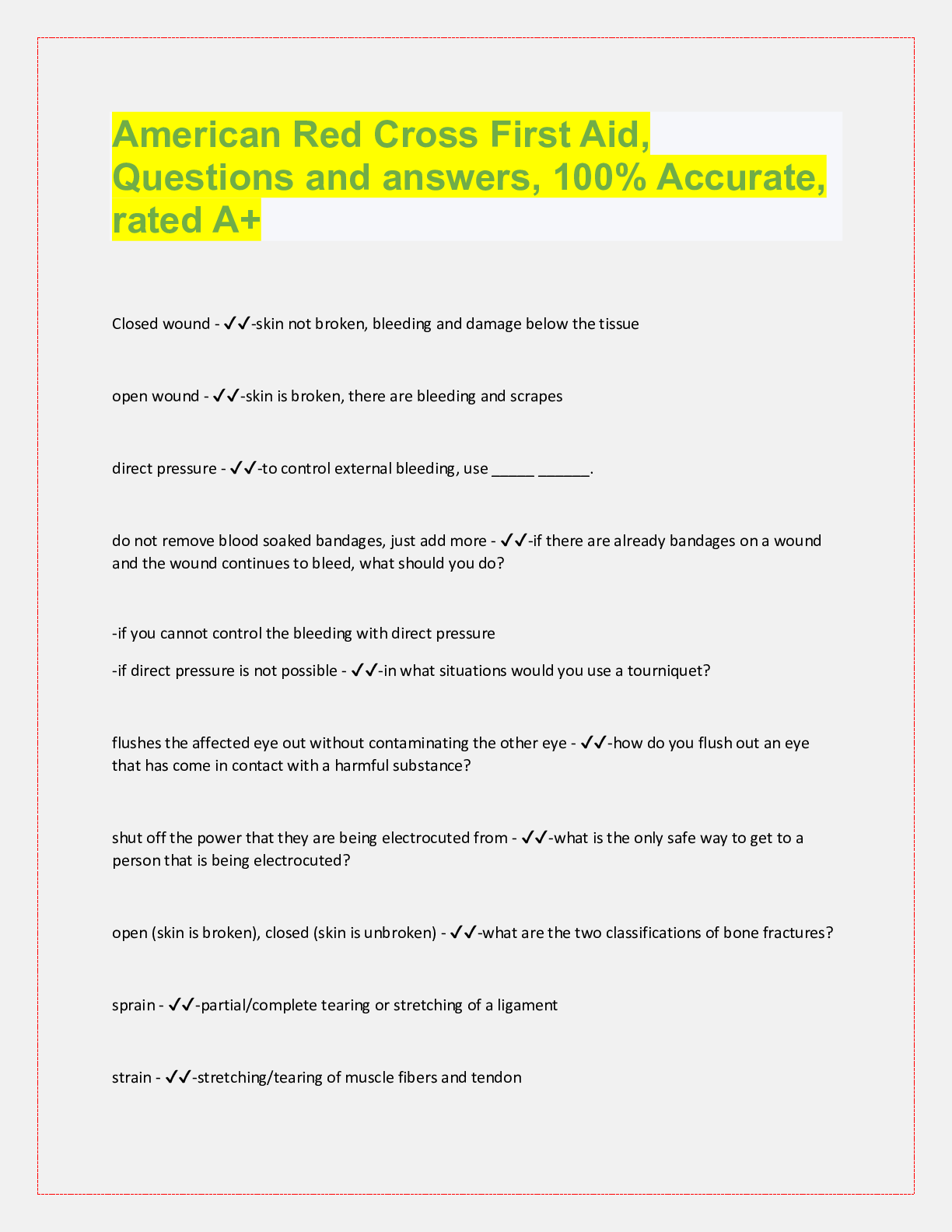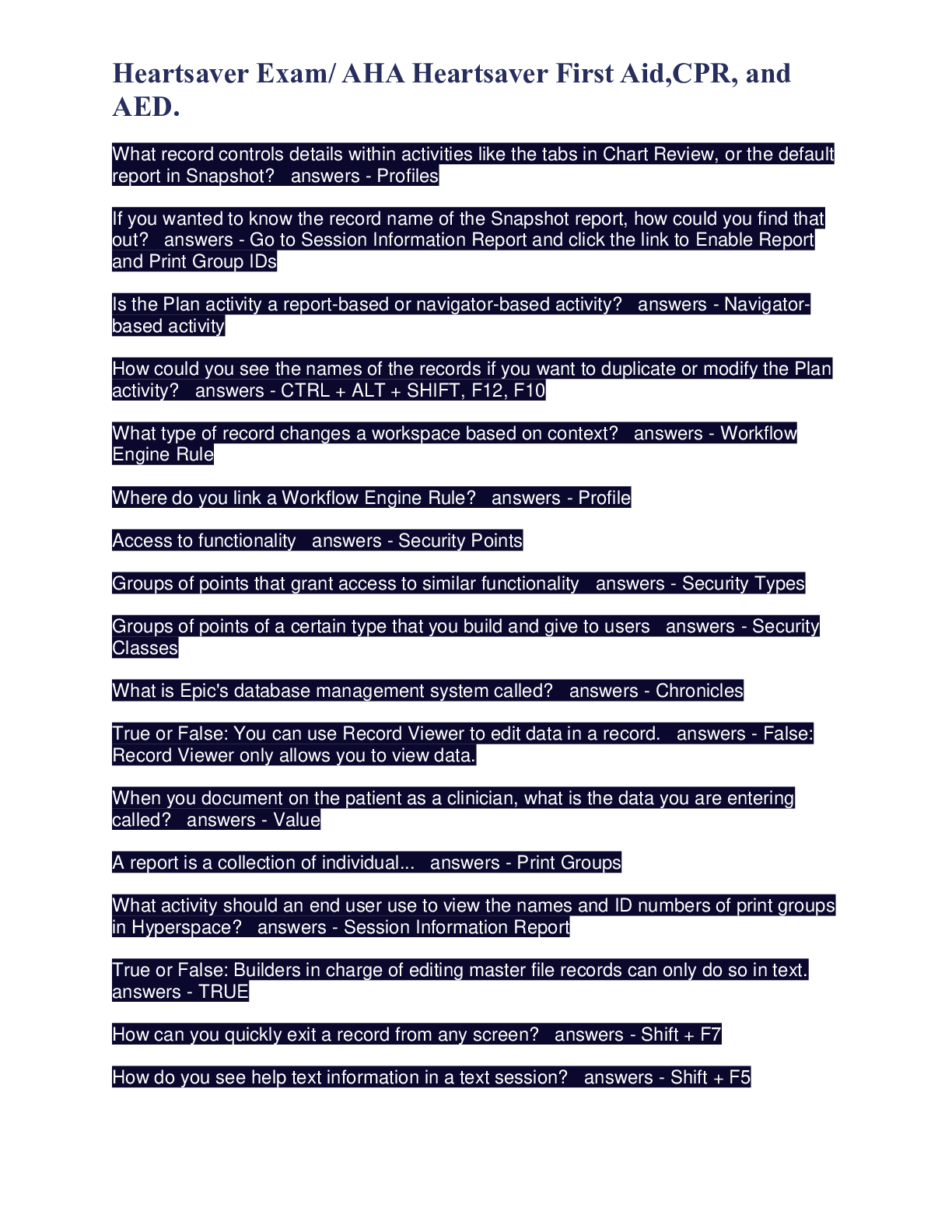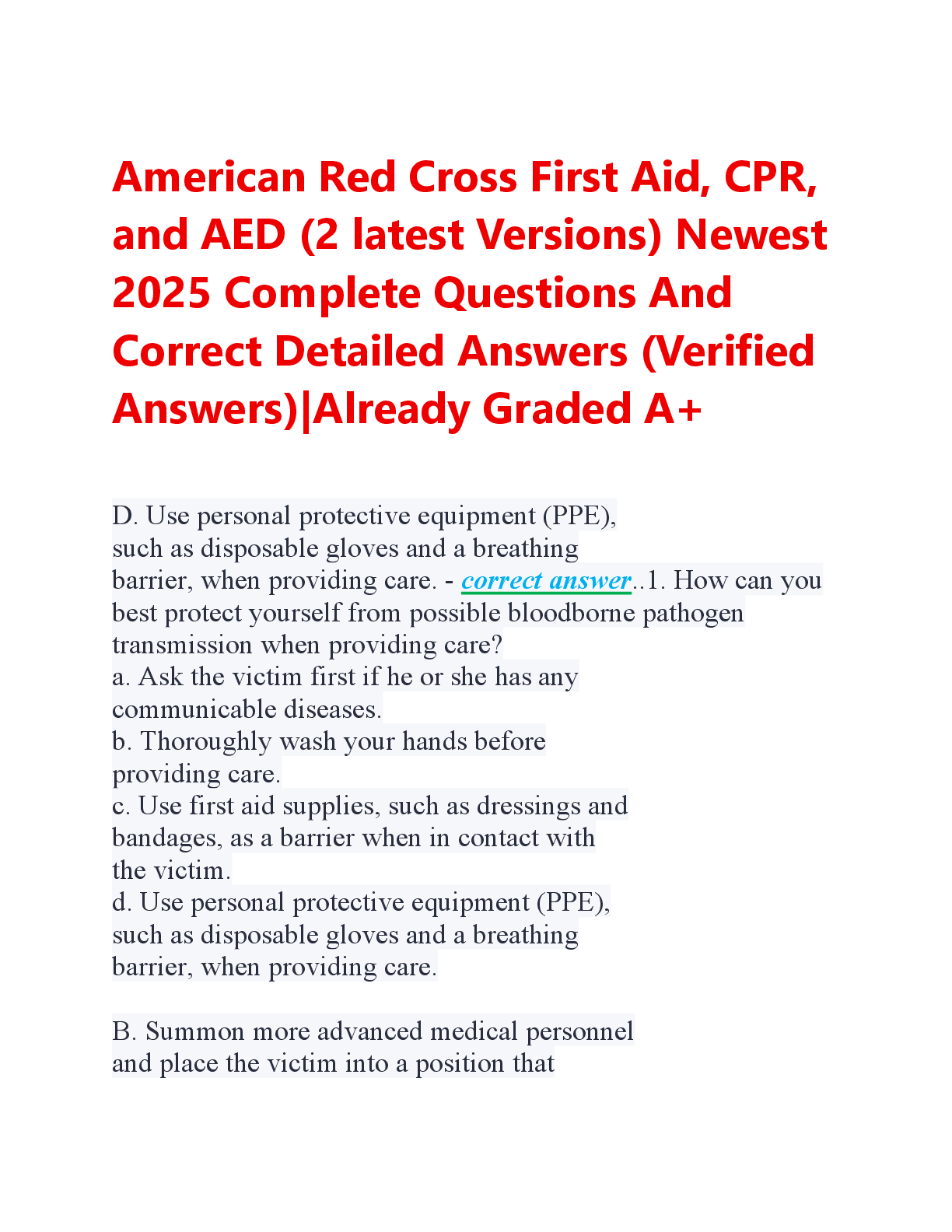Emergency Medicine > EXAM > American Red Cross First Aid, CPR, and AED Exam (health packet answers) Updated Deeply Elaborated So (All)
American Red Cross First Aid, CPR, and AED Exam (health packet answers) Updated Deeply Elaborated Solutions
Document Content and Description Below
List the four steps a lay responder (you) will take in an emergency - ANSWER 1. Recognize that an emergency exists 2. Decide to take action 3. Activate the EMS system 4. Give care consistent with y... our knowledge + training until EMS arrives + takes over List the four primary ways to RECOGNIZE an emergency - ANSWER 1. Unusual sights 2. Unusual sounds 3. Unusual odors 4. Unusual appearance/behaviors Why might a person not respond to someone who needs help? (List 4 reasons) - ANSWER -panic or fear of doing something wrong -being unsure of the person's condition + what to do -assuming someone else will take action -fear of being sued How can a person prevent disease transmission while providing help? (List 4 reasons) - ANSWER -wear gloves -avoid contact with bodily fluids -wash your hands thoroughly after giving care -use protective CPR creating barriers What is the reason for the Good Samaritan Laws? - ANSWER To protect people who voluntarily give care in an emergency situation After you recognize an emergency, decide to act, and activate EMS but BEFORE you give care you must obtain _______, if the victim refuses your help, you should...? - ANSWER CONSENT; Call EMS and not try to help further What are the three Emergency Action Steps? - ANSWER Check Call Care What is the most important step you can take to help a person who is unconscious or has some other life threatening condition? - ANSWER Call for emergency medical help When you are alone, what are the three situations in which you would "Call First"? - ANSWER -any adult or child about 12 years or older who is unconscious -a child or infant you witnessed suddenly collapse -an unconscious child or infant known to have heart problems When you are alone, what are the two situations in which you would "Care First"? - ANSWER -an unconscious child (younger than 12) who you did not see collapse -any drowning victim List 6 situations where you would call 9-1-1 - ANSWER -unconsciousness/altered level of consciousness -breathing problems -lasting chest pain, discomfort, or pressure -persistent abdominal pain or pressure -severe external breathing -severe/critical burns Do you always call 9-1-1 when an individual becomes injured, no matter how minor? Why/why not? - ANSWER Not always- you must use your judgement to determine how dire the situation is What are the 3 situations when you would have to move a victim? - ANSWER -when you are faced with immediate danger (the scene is unsafe) -when you have to get to another person with a more serious problem -when it is necessary in order to give proper care (not enough space, need a flat surface for CPR, etc.) ** If a victim is able to talk to you then you know they are breathing and have a pulse (ABC's). Assess the situation. If there aren't any other life threatening conditions (severe bleeding, etc.) find out what happened by asking questions. You follow this "interview" process whenever you deal with a conscious person (ask for consent if the individual is an adult or a child/infant with a parent). - ANSWER Checking a Conscious Person For the purposes of First Aid, define an adult, child, and infant (a.k.a. how old is each)? - ANSWER Adult: older than 12 years old Child: between the ages of 1 and 12 Infant: younger than 1 year old How should you begin the "interview"? - ANSWER Identify yourself and get the person's consent to give care What are 4 questions you should ask to gain information from a victim? - ANSWER -What happened? -Do you feel pain or discomfort anywhere? -Do you have any allergies? -Do you have any medical conditions or are you taking an medications? What is one of the most dangerous threats to a seriously ill or injured person? - ANSWER unnecessary movement What is shock? List 4 signals that might indicate a person is going into shock AND list 4 steps to treat/prevent shock. - ANSWER SIGNALS: -restlessness or irritability -altered level of consciousness -nausea or vomiting -pale, ashen, or graying, cool, moist skin TREATMENT/PREVENTION: -have the person lie down flat -reassure the person -help the person maintain normal body temperature -do not give the person anything to eat or drink in case their condition is severe Under normal conditions, how long can a person be without oxygen before POSSIBLE brain damage occurs? - ANSWER 4-6 minutes Define respiratory distress and respiratory arrest: - ANSWER Distress: a condition in which breathing becomes difficult Arrest: a condition when breathing has stopped List 4 signals that indicate a person is in respiratory distress: - ANSWER -trouble breathing or no breathing -slow or rapid breathing -unusually deep or shallow breathing -gasping for breath What are the two skills used to clear on obstructed airway in conscious choking: - ANSWER Adult/child: let him/her keep coughing Infant: if they cannot cry or breathe, give 5 back blows, then 5 chest thrusts In what situations do you stop giving care to a conscious choking victim? (LIST 3) - ANSWER -EMS takes over -scene becomes unsafe -you are too exhausted to continue Describe the best way to check for responsiveness: - ANSWER Adult/Child: tap him/her on the shoulder + ask if he/she is ok, speaking loudly Infant: tap the infant's shoulder or flick the bottom of their foot and shout When we come upon an unconscious victim we are able to see if our victim has one of these systems by checking their ____ ____ ____'s (three letters). What do these letters stand for? - ANSWER ABC's- *A*irway, *B*reathing, *C*irculation In reference to our ABC's, the letter "B" means: What do we *look* for? What do we *listen* for? What do we *feel* for? - ANSWER Breathing -look for the person's chest clearly rising and falling -listen for escaping air -feel for the escaping air on the side of your face An emergency involving an unconscious child is more likely a _________ emergency. - ANSWER breathing An emergency involving an unconscious adult is more likely a _______ emergency. - ANSWER cardiac What is the purpose of recovery position? What body systems must be working in the victim when you place him/her in the recovery position? (Otherwise you would still be treating the victim!!!!) - ANSWER To keep the airway open and clear; the respiratory system must be working WHEN can behaviors/habits that may possibly harm the heart and blood vessels begin? - ANSWER at any age Name four controllable risk factors that increase the risk of heart disease. - ANSWER -smoking -poor diet -high cholesterol/blood pressure -overweight List 5 signals/symptoms of a heart attack. - ANSWER *These vary from person to person and between men + women, but common signals include:* -chest pain/pressure/discomfort that lasts longer than 3-5 minutes and cannot be relieved -pain may spread to arm(s), upper stomach, back, etc. -pale, graying skin -dizziness or nausea -may feel unusually tired or anxious [Show More]
Last updated: 2 years ago
Preview 1 out of 15 pages

Buy this document to get the full access instantly
Instant Download Access after purchase
Buy NowInstant download
We Accept:

Reviews( 0 )
$9.00
Can't find what you want? Try our AI powered Search
Document information
Connected school, study & course
About the document
Uploaded On
Oct 29, 2022
Number of pages
15
Written in
Additional information
This document has been written for:
Uploaded
Oct 29, 2022
Downloads
0
Views
59
















